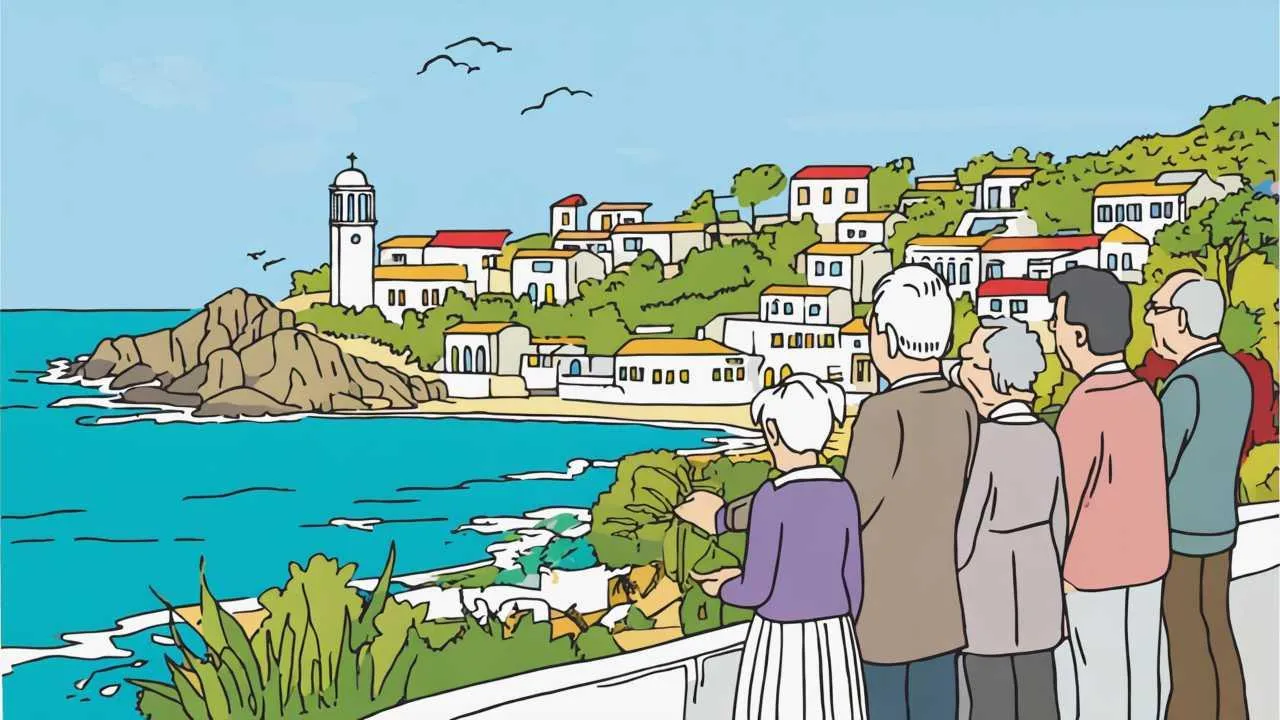Portugal has become one of the most welcoming destinations for senior travelers seeking comfort, safety, and cultural richness. With its mild climate, accessible infrastructure, excellent healthcare system, and English-speaking population, this Atlantic gem offers everything you need for a memorable journey. Whether you’re drawn to Lisbon’s historic neighborhoods, Porto’s riverside charm, or the Algarve’s stunning coastline, Portugal provides senior-friendly experiences without compromising on adventure. This comprehensive guide walks you through practical planning, essential tips, and insider strategies to make your Portuguese adventure comfortable, safe, and truly unforgettable.
Table of Contents
- Why Portugal is Perfect for Senior Travelers
- Best Regions for Senior Travelers
- Planning Your Trip: Essential Preparations
- Transportation Options and Accessibility
- Dining and Culinary Experiences
- Health and Safety Considerations
- Packing Smart for Portuguese Weather
- Real Success Stories
- Frequently Asked Questions
- Action Steps to Plan Your Adventure
Why Portugal is Perfect for Senior Travelers
Portugal consistently ranks among the world’s safest countries, with a crime rate significantly lower than most European destinations. The Global Peace Index places Portugal as the 7th most peaceful nation globally, making it an exceptional choice for seniors traveling alone or in small groups. The Portuguese people are renowned for their warmth toward older visitors, often going out of their way to assist with directions or recommendations. Local culture emphasizes respect for elders, creating a welcoming atmosphere throughout your journey.
The country’s compact size means you can experience diverse landscapes—from coastal cliffs to wine valleys—without exhausting travel times. You can drive from Lisbon to Porto in three hours, or reach the Algarve beaches in two and a half hours from the capital. This geographical convenience allows for comfortable day trips while maintaining a home base, reducing the stress of constant hotel changes.
Portugal’s cost of living is approximately 30-40% lower than other Western European countries, making it budget-friendly for retirees on fixed incomes. A high-quality three-course meal with wine costs €15-25 ($16-28) per person, while museum admissions rarely exceed €10 ($11). Senior discounts are widely available on public transportation, attractions, and cultural events, further stretching your travel budget.
The climate is another major draw. With over 300 days of sunshine annually in many regions, Portugal offers mild winters and warm summers perfect for outdoor exploration. The Algarve region maintains temperatures between 60-75°F (15-24°C) even in winter months, ideal for those with arthritis or joint pain who find cold weather challenging. Unlike scorching Mediterranean destinations, Portugal’s Atlantic breezes keep summer temperatures comfortable, rarely exceeding 85°F (29°C) in coastal areas.
Healthcare quality stands out as exceptional. Portugal ranks 12th globally in the World Health Organization’s healthcare system assessment, surpassing the United States which ranks 37th. Major cities have English-speaking doctors, modern hospitals equipped with the latest technology, and pharmacies on nearly every corner. Many seniors report receiving excellent care at a fraction of U.S. costs—a routine doctor visit costs around €50-80 ($55-88) without insurance, compared to $200-300 in the United States.
English proficiency among Portuguese people, especially in tourist areas and among younger generations, eliminates significant language barriers. While learning basic Portuguese phrases shows respect and enriches your experience, you’ll rarely struggle to find someone who speaks English in cities, hotels, restaurants, and attractions. This linguistic accessibility reduces travel anxiety for seniors concerned about communication challenges.

Visual Art by Artani Paris
Best Regions for Senior Travelers
Choosing the right region depends on your interests, mobility level, and travel style. Each area of Portugal offers distinct advantages for senior travelers, from bustling cities with world-class museums to peaceful coastal towns perfect for relaxation.
Lisbon: Cultural Hub with Modern Amenities
The capital city offers excellent public transportation with senior discounts, elevator-equipped metro stations, and countless museums within manageable walking distances. The city’s famous tram 28 provides a scenic tour through historic neighborhoods including Alfama, Graça, and Estrela, though visiting during weekday mornings avoids tourist crowds that make boarding difficult. Bairro Alto and Alfama districts have steep hills characteristic of Lisbon’s seven-hill topography, but modern accessibility initiatives have added handrails, rest benches, and alternative flat routes throughout.
Lisbon’s cultural offerings are extraordinary. The Gulbenkian Museum houses one of Europe’s finest private art collections, while the MAAT (Museum of Art, Architecture and Technology) showcases contemporary works in a stunning riverside building. Most museums offer senior discounts of 30-50% and provide seating throughout galleries. The city’s café culture encourages leisurely afternoons at historic establishments like A Brasileira or Café Martinho da Arcada, where you can rest while soaking in local atmosphere.
Porto: Wine Country Elegance
Portugal’s second city combines baroque architecture with world-famous wine culture along the picturesque Douro River. The Ribeira waterfront district is mostly flat and pedestrian-friendly, featuring colorful buildings, riverside restaurants, and easy access to port wine cellars across the river in Vila Nova de Gaia. River cruises on the Douro offer relaxing sightseeing without walking fatigue, with most boats featuring accessible boarding and onboard restrooms.
Porto’s metro system includes elevators at all stations and clear signage in Portuguese and English. The city’s compact center allows exploration of major attractions—Livraria Lello bookstore, São Bento train station with its famous azulejo tiles, and the Dom Luís I Bridge—within a manageable area. Port wine cellar tours cater to all mobility levels, with many offering golf cart transportation through facilities and comfortable tasting rooms.
The Algarve: Purpose-Built Comfort
This southern coastal region is purpose-built for comfortable living and tourism, making it exceptionally senior-friendly. Towns like Lagos, Tavira, Albufeira, and Carvoeiro feature flat coastal promenades, accessible beaches with wooden walkways extending to the water’s edge, and numerous golf courses designed for all skill levels. The region has Portugal’s highest concentration of English speakers due to its large expatriate community, making navigation and communication effortless for non-Portuguese speakers.
The Algarve’s climate is the mildest in Portugal, with winter temperatures rarely dropping below 60°F (16°C) and summer breezes moderating heat. Beach accessibility is outstanding—many beaches provide beach wheelchairs free of charge, accessible parking, and adapted changing facilities. The region’s infrastructure caters specifically to retirees, with excellent medical facilities, pharmacies, and services oriented toward older residents and visitors.
Douro Valley: Scenic Wine Tourism
For wine enthusiasts, the Douro Valley presents breathtaking terraced vineyards with several senior-friendly quintas (wine estates) offering tours with minimal walking. The scenic train route from Porto requires only three hours and provides panoramic valley views without driving stress. Many quintas offer accommodation, allowing multi-day stays exploring the region at a relaxed pace.
River cruises specifically designed for the Douro Valley cater to senior travelers with accessible cabins, elevator access to dining areas, and excursions tailored to various mobility levels. These cruises eliminate the need for constant packing and unpacking while providing comprehensive valley exploration. Most include wine tastings, traditional Portuguese meals, and cultural performances onboard.
| Region | Best For | Accessibility Rating | Avg Daily Cost | English Spoken |
|---|---|---|---|---|
| Lisbon | Culture, Museums, History | High (4/5) | $80-120 | Very High |
| Porto | Wine, Architecture, River Views | High (4/5) | $70-110 | High |
| Algarve | Beach, Golf, Relaxation | Very High (5/5) | $90-130 | Very High |
| Douro Valley | Wine Tours, Scenery | Medium (3/5) | $100-150 | Medium |
| Coimbra | University Town, Gardens | Medium (3/5) | $60-90 | Medium |
| Évora | Roman History, Wine | Medium (3/5) | $65-95 | Low |
Planning Your Trip: Essential Preparations
Start planning 3-6 months before departure to secure the best accommodations and flight prices while allowing time for medical consultations and document preparation. Early planning also reduces stress and allows for thoughtful itinerary development that balances activity with rest.
Passport and Entry Requirements
U.S. citizens need only a valid passport for stays up to 90 days within a 180-day period under Schengen Agreement rules. Ensure your passport has at least six months validity beyond your planned return date—some airlines refuse boarding with less than six months remaining. Portugal doesn’t require visas for American tourists staying under 90 days, simplifying entry procedures significantly.
Make two copies of your passport photo page: leave one with a trusted person at home and pack one separately from your passport while traveling. Consider photographing your passport and storing the image in secure cloud storage for emergency access. This precaution proves invaluable if your passport is lost or stolen.
Travel Insurance: Non-Negotiable for Seniors
The Portuguese government doesn’t require travel insurance, but purchasing comprehensive coverage is strongly recommended for seniors. Medicare provides no international coverage except in extremely limited circumstances near Canadian and Mexican borders. Comprehensive travel insurance typically costs $150-300 for two-week coverage depending on age, pre-existing conditions, and coverage limits.
Look for policies including medical evacuation coverage (minimum $100,000), pre-existing condition waivers if purchased within 14-21 days of initial trip deposit, trip cancellation/interruption coverage, and 24/7 assistance hotlines with English-speaking operators. Companies specializing in senior travel insurance include Allianz, Travel Guard, and InsureMyTrip. Read policies carefully regarding age limits—some insurers cap coverage at age 75 or 80, while others specialize in older travelers.
Medical Preparation
Schedule a check-up with your primary care physician 4-6 weeks before departure. Discuss your itinerary and request medical clearance for travel, especially if you have chronic conditions requiring management. Ask your doctor to prepare a letter on official letterhead listing all medications, medical conditions, and any medical devices you use. This letter proves invaluable if you need medical care abroad or encounter customs questions about medications.
Bring a 30-day supply plus one week extra of all medications in original packaging with prescription labels clearly visible. Pack medications in carry-on luggage, never checked bags, to prevent loss. Create a medication list including generic names (not just brand names) since Portuguese pharmacies use different brand names. Common medications like metformin, lisinopril, and atorvastatin are widely available, but knowing generic names facilitates communication.
Pack a comprehensive first-aid kit including adhesive bandages, antibiotic ointment, pain relievers (both acetaminophen and ibuprofen), antacids, anti-diarrheal medication, motion sickness tablets, and any personal medical devices like blood pressure monitors or glucose meters. Include sunscreen (SPF 30+), insect repellent, and blister treatment for walking-intensive days.
Financial Planning
Notify your bank and credit card companies of travel dates and destinations to avoid fraud holds that can leave you without access to funds. Ask about foreign transaction fees—many credit cards charge 2-3% on international purchases, while others like Capital One and Chase Sapphire cards charge nothing. Consider obtaining a card with no foreign transaction fees specifically for travel.
While credit cards are widely accepted in Portugal, small vendors, rural areas, and traditional markets prefer cash. ATMs (called Multibanco in Portugal) are everywhere and offer better exchange rates than currency exchanges or exchanging money before departure. Daily withdrawal limits typically range from €200-400 ($220-440). Inform your bank of higher withdrawal limits if you plan larger cash needs.
Consider bringing $200-300 in euros for immediate expenses upon arrival—taxi from airport, first meal, incidentals. This eliminates the stress of finding ATMs immediately after a long flight when you’re tired. Never exchange money at airport currency exchanges, which offer terrible rates and high fees.
Accommodation Selection
Book accommodations with accessibility in mind. Request ground-floor rooms or confirm elevator availability when reserving hotels. Portugal’s traditional buildings often lack elevators, but newer hotels and renovated properties meet modern accessibility standards. Websites like Booking.com and Airbnb allow filtering by accessibility features including grab bars, wheelchair access, roll-in showers, and walk-in showers without high thresholds.
Read recent reviews specifically mentioning accessibility and senior-friendliness. Contact hotels directly to confirm specific needs—photos don’t always reveal threshold heights, bathroom layouts, or distance from elevators to rooms. Many Portuguese hotels go above and beyond to accommodate senior guests when contacted in advance.
Transportation Options and Accessibility
Portugal’s public transportation system accommodates seniors exceptionally well, with modern infrastructure, clear signage, and widespread accessibility features that make navigation straightforward even for first-time visitors.
Metro Systems: Lisbon and Porto
Lisbon’s metro features elevators at most stations built or renovated in recent decades, priority seating clearly marked in each car, and clear signage in Portuguese and English. The four color-coded lines (Blue, Yellow, Green, Red) connect major tourist areas efficiently. The rechargeable Viva Viagem card offers significant savings over individual tickets—seniors over 65 qualify for 50% discounts on all public transport when presenting proof of age.
Porto’s metro is newer and even more accessible, with all stations featuring elevator access. The system extends to the airport and nearby beach towns, providing comprehensive coverage. Both cities’ metros operate from 6:00 AM to 1:00 AM, with some lines extending to 2:00 AM on weekends.
Buses and Trams
City buses have low-floor entry points and dedicated senior seating near the front, making boarding and alighting easier. Drivers are generally patient with seniors and will wait for you to sit before departing. Lisbon’s famous tram 28 is a tourist attraction itself but can be crowded—ride early morning (before 9:00 AM) or late afternoon (after 5:00 PM) for seats and easier boarding.
Modern trams in Lisbon are fully accessible with level boarding, while vintage trams require stepping up. If mobility is limited, stick to bus routes covering the same areas—they’re air-conditioned and more comfortable for longer rides.
Trains: Comfortable Intercity Travel
Comboios de Portugal (CP) operates modern trains with spacious seating, onboard restrooms, and luggage assistance. The Alfa Pendular high-speed service links Lisbon to Porto in 2 hours 45 minutes with reclining seats, air conditioning, and café cars. Intercity trains are slower but equally comfortable, serving smaller cities and towns.
Seniors over 65 receive 25% discounts on most routes when booking at stations—online discounts vary and sometimes exclude senior rates. Purchase tickets from station ticket offices rather than machines to ensure you receive applicable discounts. Station staff speak English at major hubs and assist with platform navigation.
Regional trains connect smaller towns economically. While less luxurious than Alfa Pendular or Intercity services, regional trains offer authentic local experiences and access to areas not served by express services. Seats are first-come, first-served, so arrive 15 minutes early for the best selection.
Taxis and Ride-Sharing
Taxis are affordable alternatives to public transportation. A typical 15-minute ride costs €8-12 ($9-13). Portuguese taxi drivers often speak basic English and appreciate tips of 10-15%. Official taxis are cream-colored or black with green roofs in Lisbon, and black with cream roofs in Porto. Always use official taxis or ride-sharing services—unlicensed taxis at airports charge inflated rates.
Uber and Bolt ride-sharing services operate throughout Portugal with excellent coverage in cities and tourist areas. Prices are slightly lower than traditional taxis, and apps eliminate language barriers regarding destinations. Both services allow you to save favorite locations like your hotel for easy return navigation.
Private Drivers and Tours
For longer stays or day trips, consider hiring private drivers through hotels or reputable tour companies. Expect to pay €150-200 ($165-220) for 8-hour excursions including fuel and driver knowledge. Private drivers offer flexibility—stopping for photos, adjusting itineraries based on your energy levels, and providing restaurant recommendations.
Many companies offer senior-specific tours with slower pacing, frequent rest stops, and assistance with walking. These tours cost more than standard group tours but provide significantly better experiences for those with mobility concerns or preferring smaller groups.
Renting a Car: Pros and Cons
Renting a car offers flexibility but comes with challenges. Portuguese drivers can be assertive, especially in cities, and parking in historic centers is limited and expensive. If you choose to rent, automatic transmissions cost €10-15 more daily, and GPS navigation is essential for rural areas where signage can be confusing.
International drivers over 70 may face additional scrutiny or higher insurance rates depending on the rental company. Some companies require medical clearance letters for drivers over 75. Portuguese law requires carrying your driver’s license, passport, rental agreement, and insurance documents at all times while driving.
Toll roads (autoestradas) are common and electronic-only in many areas. Rental companies provide toll transponders or license plate-linked billing—clarify the system before driving to avoid fines. Gas is expensive compared to U.S. prices, currently around €1.80-2.00 per liter ($7.50-8.30 per gallon).
| Transportation | Cost Range | Best For | Accessibility | Senior Discount |
|---|---|---|---|---|
| Metro (Lisbon/Porto) | €1.50-3.00 | City travel | Excellent | 50% (65+) |
| Bus | €2.00-4.00 | Local routes | Good | 50% (65+) |
| Alfa Pendular Train | €25-35 | Lisbon-Porto | Excellent | 25% (65+) |
| Taxi (15 min) | €8-12 | Point-to-point | Good | None |
| Uber/Bolt | €6-10 | City travel | Good | None |
| Private Driver (8hr) | €150-200 | Day trips | Excellent | Negotiable |
Dining and Culinary Experiences
Portuguese cuisine emphasizes fresh ingredients, olive oil, and seafood—heart-healthy choices ideal for seniors watching cholesterol and blood pressure. Traditional cooking methods like grilling, roasting, and stewing avoid excessive fats while maximizing flavor through herbs, garlic, and quality ingredients.
Traditional Restaurants and Meal Times
Traditional restaurants called “tascas” or “cervejarias” serve generous portions at reasonable prices in unpretentious settings. A full meal including appetizers, main course, dessert, and wine typically costs €15-25 ($16-28) per person. Portion sizes are substantial—don’t hesitate to share dishes or request half portions, which many restaurants accommodate willingly.
Most restaurants open for lunch at 12:30 PM and dinner at 7:30 PM, later than American standards but earlier than Spanish traditions. Tourist areas accommodate earlier dining, with many restaurants opening at 6:00 PM for dinner. Lunch is the main meal traditionally, often featuring daily specials (prato do dia) offering excellent value—complete meals for €8-12 including soup, main course, dessert, and beverage.
Senior-Friendly Dishes
Bacalhau (salted cod) appears in over 365 recipes—Portuguese tradition claims one for each day of the year. Popular preparations include bacalhau à brás (shredded cod with eggs and potatoes), bacalhau com natas (cod in cream sauce), and bacalhau assado (roasted cod). While traditionally salted, modern preparations reduce sodium content significantly.
Other senior-friendly dishes include caldeirada (fish stew loaded with vegetables and white fish), frango assado (roasted chicken with herbs), cozido à portuguesa (meat and vegetable stew), and arroz de marisco (seafood rice similar to paella but soupier). Grilled fish—including dourada (sea bream), robalo (sea bass), and sardines—appears on every coastal menu, typically served with boiled potatoes and steamed vegetables.
Soups begin most traditional meals. Caldo verde (kale and potato soup) and sopa de peixe (fish soup) provide nutritious, filling starts. Don’t feel obligated to finish everything—Portuguese hospitality means generous portions, and servers don’t judge leftovers.
Pastéis de Nata and Café Culture
Portugal’s famous pastéis de nata (custard tarts) make perfect mid-morning treats with coffee. Pastéis de Belém in Lisbon serves the original recipe since 1837 in a sprawling café with indoor seating and accessible restrooms. Expect lines, but they move quickly. Each tart costs only €1.40, and many seniors enjoy them warm with cinnamon sugar and a bica (espresso).
Café culture encourages leisurely afternoons at historic establishments. Order a bica (espresso), meia de leite (half coffee, half milk), or galão (large latte in a glass) and relax while watching street life. Most cafés don’t rush customers—sitting for an hour over one coffee is perfectly acceptable and encouraged.
Dietary Restrictions and Accommodations
Portuguese restaurants accommodate dietary restrictions with advance notice. While traditional cuisine is meat and fish-centric, vegetarian options have expanded dramatically in recent years. Lisbon and Porto have dedicated vegetarian and vegan restaurants, and most traditional restaurants offer vegetable-based dishes.
Gluten-free awareness is growing, though less common than in the United States. Celiac Portugal (Associação Portuguesa de Celíacos) provides restaurant lists and translation cards. Many upscale restaurants now offer gluten-free bread and pasta alternatives.
Communicate allergies clearly using phrases like “Sou alérgico a…” (I’m allergic to…) or “Não posso comer…” (I cannot eat…). Carry a card listing restrictions in Portuguese—hotels provide these or print them from translation websites. Waitstaff take allergies seriously and consult chefs about ingredient safety.

Visual Art by Artani Paris
Health and Safety Considerations
Portugal ranks as one of Europe’s safest countries with crime rates significantly below most Western European nations and far below major U.S. cities. The 2024 Global Peace Index places Portugal 7th globally for safety and security.
Crime and Personal Safety
Violent crime against tourists is extremely rare. Petty theft like pickpocketing occurs in tourist areas, particularly on Lisbon’s tram 28, Rossio Square, Bairro Alto at night, and Porto’s Ribeira district. Use anti-theft bags with slash-resistant straps and RFID-blocking pockets, avoid displaying expensive jewelry or watches, and keep valuables in hotel safes.
Common sense precautions ensure safe travel: avoid dark, isolated areas at night; don’t leave bags unattended; keep wallets in front pockets; and be cautious of distraction techniques (someone spilling on you while an accomplice steals your bag). The vast majority of senior travelers report feeling safer in Portugal than in major U.S. cities, often walking at night without concern.
Police are professional, helpful, and visible in tourist areas. The Tourist Police (Polícia de Segurança Pública – PSP) in major cities have English-speaking officers specifically trained to assist visitors. Don’t hesitate to approach police for directions or assistance—they’re genuinely helpful and welcoming.
Medical Facilities and Healthcare Access
Hospitals in Lisbon and Porto meet or exceed Western standards, with dedicated international patient departments staffed by English-speaking personnel. Portugal’s healthcare system emphasizes universal access, meaning emergency care is free under reciprocal agreements for tourists, though non-emergency treatment may require payment (later reimbursed by travel insurance).
Major hospitals with excellent reputations include Hospital da Luz and Hospital CUF in Lisbon, and Hospital da Prelada in Porto. Private hospitals offer faster service than public hospitals and cater specifically to international patients. Private emergency room visits cost approximately €100-150, while specialist consultations range from €80-120—significantly less than U.S. costs even without insurance.
The European emergency number 112 works throughout Portugal for ambulance, police, or fire services. Operators speak English and can dispatch appropriate services quickly. Response times in urban areas are excellent, typically under 10 minutes for emergency calls.
Pharmacies: Accessible Healthcare Support
Pharmacies display green crosses and operate extended hours in rotating shifts—at least one pharmacy in each area remains open 24/7. Posted signs list nearby 24-hour pharmacies, or call 118 for information. Pharmacists in Portugal are highly trained medical professionals who can recommend over-the-counter solutions for minor ailments like colds, digestive issues, or muscle pain.
Common medications like ibuprofen (Brufen), acetaminophen (Ben-u-ron), antacids (Rennie), and allergy tablets (Claritine) are readily available without prescription. Portuguese pharmacies carry most international medications under different brand names—knowing generic names facilitates identification. Pharmacists speak varying levels of English, with better English in tourist areas.
Sun Protection and Hydration
Portugal’s southern latitude means stronger UV exposure than northern Europe or most U.S. states. Sun protection is essential even in winter and on cloudy days. Wear SPF 30+ sunscreen, wide-brimmed hats, and UV-protective sunglasses. Reapply sunscreen every two hours, especially if walking extensively or spending time near water.
Dehydration can occur quickly, particularly during summer months or if you’re not accustomed to walking several miles daily. Carry a refillable water bottle and drink regularly, aiming for 8-10 glasses daily. Tap water is safe throughout Portugal, though some prefer bottled water for taste. Restaurants provide free tap water when requested (“água da torneira, por favor”).
Watch for heat exhaustion symptoms: dizziness, excessive sweating, rapid pulse, or nausea. Rest in shade immediately, drink water, and seek medical attention if symptoms persist. Portuguese people take heat seriously and are accustomed to helping tourists unaccustomed to Mediterranean climates.
| Emergency Service | Contact Number | Notes |
|---|---|---|
| General Emergency | 112 | Ambulance, Police, Fire (English available) |
| Tourist Police Lisbon | +351 21 342 1623 | English-speaking officers, daily 9 AM-8 PM |
| Tourist Police Porto | +351 22 208 1833 | English support, daily 9 AM-8 PM |
| U.S. Embassy Lisbon | +351 21 727 3300 | American Citizen Services, weekdays 8-5 |
| Poison Control | 808 250 143 | 24/7 medical advice service |
| SNS 24 Health Line | 808 24 24 24 | 24/7 nurse advice (Portuguese only) |
Packing Smart for Portuguese Weather
Portugal’s weather varies significantly by season and region, requiring strategic packing to stay comfortable throughout your trip while avoiding excess luggage.
Spring (March-May): Layers and Rain Gear
Spring brings temperatures between 55-70°F (13-21°C) with occasional rain showers, particularly in northern regions. Pack layers including light sweaters, long-sleeve shirts, and a waterproof jacket with hood. Mornings can be cool (low 50s°F), while afternoons warm considerably (upper 60s°F). Comfortable walking shoes with good traction for wet cobblestones are essential.
An umbrella is useful but not critical—light rain often clears quickly. Focus on breathable fabrics that dry quickly if caught in showers. Spring flowers bloom beautifully, making this season ideal for garden enthusiasts and photographers.
Summer (June-September): Sun Protection Priority
Summer reaches 75-85°F (24-29°C) in coastal areas, hotter inland where temperatures can exceed 95°F (35°C) in Alentejo and inland Algarve. Breathable cotton or linen clothing in light colors reflects heat and allows air circulation. Sun hats with wide brims (3+ inches) provide crucial face and neck protection.
Sandals with good arch support work well for beach areas, but bring athletic shoes for city exploration where cobblestones challenge flat sandals. Evening temperatures cool pleasantly, requiring light cardigans or shawls for outdoor dining. Sunglasses with UV protection are non-negotiable—Portuguese sun is intense even on hazy days.
Fall (October-November): Comfortable Transition
Fall mirrors spring conditions with beautiful warm days (65-75°F) and cool evenings (55-60°F). This season offers ideal walking weather without summer crowds or heat. Pack similar layers to spring, with slightly warmer evening options. A light jacket for evening strolls along waterfronts or outdoor restaurants proves essential.
Fall brings harvest season in wine regions, making Douro Valley particularly spectacular. Comfortable walking shoes with ankle support help navigate vineyard tours on uneven terrain.
Winter (December-February): Mild but Wet
Winter stays mild at 50-60°F (10-16°C) in southern regions, though Lisbon and Porto can be rainy with temperatures occasionally dropping to 45°F (7°C). Waterproof shoes are essential—cobblestones become slippery when wet. An umbrella and waterproof jacket with hood protect against frequent rain showers.
Layer with thermal underwear if you’re sensitive to cold, as Portuguese buildings often lack central heating. Scarves, gloves, and warm hats are rarely needed except for early morning or late evening outings. Winter offers the advantage of minimal crowds and significantly lower prices.
Footwear: Your Most Important Packing Decision
Cobblestone streets dominate historic districts, making footwear critical to comfortable travel. Avoid smooth-soled shoes that slip on polished stones, particularly when wet. Cushioned sneakers or walking shoes with textured, rubber soles prevent falls and reduce foot fatigue from hours of exploration.
Bring two pairs of comfortable walking shoes to alternate daily, allowing shoes to dry and air out between wears. Breaking in new shoes before your trip prevents blisters—walk at least 20-30 miles in new shoes before departing. Pack blister treatment (Compeed bandages) in case of rubbing despite precautions.
Laundry and Clothing Strategy
Laundry services are widely available and affordable. Most hotels offer same-day or next-day laundry service at reasonable rates—expect €1.50-3.00 per item. Self-service laundromats exist in larger cities, typically costing €5-8 per load with wash-and-dry cycles completing in 90 minutes.
Pack travel-sized detergent for hand-washing small items (underwear, socks, lightweight shirts) in hotel sinks. Items dry overnight in warm weather, though humid conditions require longer drying times. This strategy minimizes luggage weight while ensuring clean clothes throughout your journey.
Aim for neutral colors that mix and match easily—black, navy, gray, and beige create multiple outfits from fewer pieces. Choose wrinkle-resistant fabrics when possible to avoid packing irons or paying for pressing services.
Real Success Stories
Case Study 1: Naples, Florida
Margaret R. (72 years old)
Margaret had postponed her Portugal dream for years due to concerns about managing her type 2 diabetes while traveling internationally. After careful research and consultation with her endocrinologist, she spent three weeks exploring Lisbon, Porto, and the Algarve in April 2024, traveling solo for the first time since her husband’s passing.
She pre-researched pharmacies near her hotels using Google Maps, brought a translated medication list prepared by her doctor, and wore a medical alert bracelet with her conditions and emergency contacts. Margaret discovered Portuguese restaurants accommodated her dietary needs willingly when she explained her diabetes and carbohydrate restrictions.
She maintained stable blood sugar levels successfully by choosing grilled fish and vegetables, limiting bread and pastries (despite temptation), and walking 4-5 miles daily exploring cities naturally. Her continuous glucose monitor showed better readings than typical weeks at home, likely due to the Mediterranean diet and increased activity.
Results:
- Lost 8 pounds during the trip through enjoyable walking and healthy Portuguese cuisine
- Improved her A1C levels from 7.2% to 6.8% in the three months following her trip
- Gained confidence in international travel, subsequently visiting Spain and Italy independently
- Spent approximately $2,800 total including flights ($850), averaging $95 daily for accommodations, food, transportation, and activities
- Made lasting friendships with fellow travelers and locals, staying connected via social media
“Portugal exceeded every expectation I had. I felt safer walking Lisbon streets at 10 PM than in my Naples neighborhood at noon. The Portuguese people were endlessly patient with my terrible pronunciation and helped me navigate the metro system when I was confused. My only regret is not going ten years sooner—I wasted so much time being afraid!” – Margaret R.
Case Study 2: Scottsdale, Arizona
Robert and Linda T. (both 68 years old)
This retired couple chose Portugal for their 40th anniversary celebration despite Linda’s mobility challenges from bilateral knee replacement surgery six months prior. Her orthopedic surgeon cleared her for travel but recommended limiting daily walking to 3-4 miles maximum and taking frequent rest breaks.
They carefully selected accessible accommodations through Booking.com’s accessibility filters and pre-booked private transfers to minimize walking strain and the stress of navigating public transportation with luggage. The couple focused on Porto and the Douro Valley, taking advantage of river cruises that offered comprehensive sightseeing without excessive walking demands.
They hired a private driver named João through their Porto hotel for €180 daily, allowing them to explore at their own pace with frequent rest stops, photo opportunities, and bathroom breaks. João became an invaluable resource, sharing family recipes, recommending restaurants serving authentic regional cuisine, and adjusting each day’s itinerary based on Linda’s energy levels and pain management needs.
Results:
- Visited 8 renowned port wine quintas over 10 days without physical strain or pain flare-ups
- Discovered Portugal’s accessibility infrastructure far exceeded their expectations based on concerns from friends
- Formed a lasting friendship with João, who they now consider family and exchange Christmas cards with annually
- Total trip cost of $6,200 for two people including premium four-star accommodations, private transportation, and fine dining experiences
- Linda reported that the trip motivated her physical therapy compliance, improving her knee function beyond surgeon expectations
“We almost canceled the trip three times, fearing Linda couldn’t manage the terrain and that her knees would ruin our anniversary. Portugal proved us completely wrong. Every hotel had elevators or ground-floor rooms, restaurants welcomed us with accessible seating near entrances, and João became like our Portuguese son. We’re already planning our next visit to explore Lisbon and the Algarve!” – Robert T.
Case Study 3: Portland, Oregon
James K. (76 years old)
A widower traveling solo for the first time after losing his wife of 52 years, James chose Portugal based on enthusiastic recommendations from his senior travel group. Initially anxious about language barriers, solo dining, and managing logistics independently, he discovered Portugal’s welcoming culture quickly dissolved his concerns.
James stayed in small family-run guesthouses (pensões) rather than hotels, forming genuine connections with owners who offered local recommendations, occasional dinner invitations, and even introduced him to their families. He used public transportation exclusively, purchasing a Lisboa Card for unlimited transit and museum access, and finding Portuguese transit systems remarkably easy to navigate despite initial trepidation.
His solo status prompted conversations with fellow travelers and locals that enriched his experience far beyond typical tourist interactions. He joined free walking tours where he met other solo seniors, attended local fado performances in small taverns recommended by guesthouse owners, and discovered hidden neighborhood restaurants where he became a regular over his three-week stay.
Results:
- Reduced his daily travel costs to just $65 through budget accommodations ($35/night), local eateries ($20/day), and free activities
- Made genuine friendships with fellow travelers and locals, receiving dinner invitations from three Portuguese families who remain in touch
- Overcame his fear of solo travel and social anxiety following his wife’s death, subsequently visiting Spain, Italy, and Morocco independently
- Started a travel blog sharing his experiences that now has over 5,000 monthly readers, inspiring other widowed seniors to embrace travel
- Discovered a passion for photography while documenting his journey, now exhibiting work at a Portland senior center
“Portugal gave me my life back after losing Barbara. I thought my traveling days were over, that I’d just sit home watching TV until I died. The kindness I encountered everywhere—from the guesthouse owner who invited me to her daughter’s wedding to the strangers who helped when I got lost—reminded me the world is still full of good people. I video call my Lisbon ‘family’ every month, and they’re visiting Portland next spring. At 76, I’m busier than I was at 56!” – James K.
Frequently Asked Questions
Is Portugal safe for seniors traveling alone?
Yes, Portugal consistently ranks among the world’s safest countries. The 2024 Global Peace Index places Portugal as the 7th most peaceful nation globally. Violent crime against tourists is extremely rare. Petty theft like pickpocketing occurs in crowded tourist areas (particularly Lisbon’s tram 28 and Rossio Square), but exercising normal precautions—securing valuables, using anti-theft bags, avoiding isolated areas at night—ensures safe travel. The vast majority of senior travelers report feeling safer in Portugal than in major U.S. cities. Solo female travelers over 60 particularly praise Portugal’s respectful culture and helpful locals who go out of their way to assist older visitors.
Do I need travel insurance for Portugal?
While not legally required for entry, travel insurance is highly recommended and arguably essential for seniors. Medicare provides no coverage outside the United States except in extremely limited border situations. Comprehensive policies covering medical emergencies, trip cancellation, and lost luggage cost $150-300 for two weeks depending on your age, coverage limits, and pre-existing conditions. Look for policies including medical evacuation coverage (minimum $100,000), pre-existing condition waivers if purchased within 14-21 days of initial trip deposit, and 24/7 assistance hotlines with English-speaking operators. Companies specializing in senior travel insurance include Allianz Global Assistance, Travel Guard, and InsureMyTrip comparison service.
How much English is spoken in Portugal?
English proficiency is widespread in tourist areas, hotels, restaurants, and among younger Portuguese generations. In Lisbon, Porto, and the Algarve, you’ll rarely struggle to find English speakers—most hospitality workers, shopkeepers, and many locals speak functional to fluent English. Rural areas and small towns have less English fluency, but Portuguese people are remarkably patient and helpful, often using translation apps or finding someone nearby who speaks English. Learning basic phrases like “obrigado/obrigada” (thank you), “por favor” (please), “fala inglês?” (do you speak English?), and “não compreendo” (I don’t understand) shows respect and is always appreciated, often prompting extra assistance from locals.
What is the best time of year for seniors to visit Portugal?
Spring (April-June) and fall (September-October) offer ideal conditions for senior travelers—mild temperatures between 65-75°F (18-24°C), fewer crowds than summer peak season, lower accommodation prices (30-40% less than July-August), and comfortable walking weather. April brings blooming flowers and Easter festivals. September provides warm beach weather without July-August tourist crowds and still-warm ocean temperatures. Winter (November-February) attracts seniors seeking mild weather and rock-bottom prices (50% less than summer), though expect occasional rain and cooler temperatures. Summer (July-August) brings the hottest weather, highest prices, and largest crowds but guarantees sunshine and vibrant atmospheres.
Can I use my Medicare in Portugal?
No, Medicare provides no coverage outside the United States except in very limited circumstances involving Canadian and Mexican borders. You must purchase private travel medical insurance or pay out-of-pocket for medical care and later seek reimbursement from travel insurance if purchased. The good news is Portuguese healthcare costs significantly less than U.S. care—a doctor’s visit costs €50-80 ($55-88), specialist consultations €80-120 ($88-132), and prescription medications are often one-third of U.S. prices. Emergency room visits at private hospitals cost approximately €100-150 ($110-165). Keep all receipts and medical documentation for insurance reimbursement claims upon returning home.
How accessible is Portugal for seniors with mobility issues?
Accessibility varies significantly by location. Major cities like Lisbon and Porto have modernized considerably with elevators in metro stations (though not all older stations), accessible buses with low-floor boarding, and wheelchair-friendly major attractions. The Algarve region offers the best accessibility with flat coastal paths, beach wheelchairs available free at many beaches, and purpose-built facilities. Historic neighborhoods feature cobblestone streets (often uneven), steep hills, and narrow sidewalks that challenge wheelchairs, walkers, and those with balance issues. Research specific accommodations and attractions beforehand. The Portuguese Tourism Board website (visitportugal.com) provides detailed accessibility information, and specialized companies like Accessible Portugal offer mobility-friendly customized tours.
What should I do if I lose my medication in Portugal?
Visit any pharmacy (identified by green crosses) with your prescription bottle, a photo of the prescription label, or your doctor’s medication letter. Portuguese pharmacists can often provide equivalent medications using generic names, which is why carrying a list of generic drug names (not just brand names) is crucial. For controlled substances like opioids or benzodiazepines, you may need a local doctor’s prescription—visit a health center (centro de saúde) or private clinic where English-speaking doctors can evaluate your needs. Bring copies of all prescriptions from home, a doctor’s letter listing your medications in generic names, and consider travel insurance with prescription replacement coverage for additional peace of mind. Most common medications are available and inexpensive in Portugal.
Are Portuguese restaurants accommodating for dietary restrictions?
Yes, increasingly so, especially in larger cities and tourist areas where international visitors are common. Vegetarian and gluten-free options have expanded significantly in recent years, with dedicated vegetarian/vegan restaurants in Lisbon and Porto. Traditional Portuguese cuisine is fish and meat-centric, but restaurants willingly accommodate allergies and restrictions when notified—preferably when making reservations or immediately upon seating. Carry a card listing your restrictions in Portuguese (many hotels provide these, or print them from translation websites) for clear communication. Phrases like “Sou alérgico a…” (I’m allergic to…) or “Não posso comer…” (I cannot eat…) help communicate needs. Kosher and halal options exist primarily in Lisbon. Celiac-friendly restaurants are growing in number—check Celiac Portugal (Associação Portuguesa de Celíacos) for current listings.
How much should I budget daily for comfortable travel in Portugal?
Budget-conscious seniors can manage comfortably on $65-85 daily using public transportation ($5-10), staying in clean guesthouses or budget hotels ($35-45), and eating at local restaurants and cafés ($25-30). Mid-range comfort requires $100-150 daily for decent three-star hotels ($60-80), occasional taxis or Uber ($10-15), and restaurant meals with wine ($30-45). Luxury travelers seeking four-star accommodations, private guides, and fine dining should budget $200-300+ daily. These estimates exclude international flights but include accommodation, meals, local transportation, attraction admissions, and incidentals. Portugal remains 30-40% less expensive than France, Italy, or Spain for equivalent experiences, making it excellent value for European travel.
Can I extend my stay beyond 90 days in Portugal?
U.S. citizens can stay visa-free for 90 days within any 180-day period under Schengen Agreement rules covering 27 European countries. Extensions beyond 90 days require applying for a long-stay visa or residence permit through Portuguese immigration (SEF – Serviço de Estrangeiros e Fronteiras) before your initial 90 days expire. Many seniors explore Portugal’s D7 passive income visa (residence visa) for longer stays, requiring proof of minimum income levels (€820 monthly for single person, €1,230 for couples as of 2025) and Portuguese residency establishment. The Golden Visa program requires significant investment (€500,000+ in real estate or qualifying investments). Overstaying your 90-day allowance results in fines and potential Schengen area bans. Consult with Portuguese immigration attorneys or the Portuguese Embassy for current requirements, as rules change periodically.
What vaccinations do I need for Portugal?
No special vaccinations are required for U.S. citizens traveling to Portugal beyond routine immunizations. The CDC recommends ensuring you’re current on routine vaccines including influenza, COVID-19, tetanus-diphtheria, and shingles (Shingrix for those 50+). Consider hepatitis A vaccination if you’ll be eating at small local establishments or rural areas, though Portugal’s food safety standards are excellent. Hepatitis B is recommended only for those with specific risk factors. Tick-borne encephalitis vaccination may be considered if hiking extensively in rural northern Portugal during spring and summer, though risk is low. Consult your doctor or a travel medicine clinic 4-6 weeks before departure for personalized recommendations based on your health status, itinerary, and planned activities.
Action Steps to Plan Your Portuguese Adventure
- Check your passport expiration date immediately—renew if it expires within 6 months of your planned return, as passport processing currently takes 6-8 weeks for routine service or 2-3 weeks for expedited service
- Schedule a comprehensive check-up with your primary care physician 4-6 weeks before departure to discuss travel fitness, update vaccinations, and request a detailed medication letter with generic drug names
- Research and purchase travel insurance by comparing at least three providers (Allianz, Travel Guard, InsureMyTrip) for coverage breadth, price, and customer service reviews—do this within 14-21 days of booking flights for pre-existing condition waivers
- Decide on your preferred regions based on interests (culture, beaches, wine, history) and create a realistic itinerary allowing rest days between high-activity days—most seniors find 2-3 nights per location prevents exhausting constant movement
- Book accommodations 2-3 months ahead for best prices and selection, prioritizing accessibility features (elevators, ground-floor rooms, walk-in showers), central locations near attractions, and positive senior traveler reviews
- Notify your bank and all credit card companies of exact travel dates and destinations to prevent fraud holds—ask about foreign transaction fees and consider obtaining a no-fee card if your current cards charge 2-3% per transaction
- Download essential smartphone apps before departure: Google Translate (download Portuguese for offline use), Maps.me (offline maps), XE Currency (exchange rates), Uber and Bolt (ride-sharing), CP train schedules (Comboios de Portugal), and WhatsApp (free international communication)
- Learn 10-15 basic Portuguese phrases using YouTube videos or language apps to show respect and facilitate basic communication—focus on greetings, thank you, please, excuse me, and emergency phrases
- Pack strategically with comfortable broken-in walking shoes (two pairs), layered clothing appropriate for your travel season, sun protection (hat, sunglasses, SPF 30+ sunscreen), and a comprehensive first-aid kit with all medications in original packaging
- Create both digital and paper document folders containing copies of passport, travel insurance policy and emergency numbers, flight confirmations, hotel reservations, prescriptions, and emergency contacts—email copies to yourself and leave one set with a trusted person at home
Disclaimer
This article is provided for informational purposes only and does not constitute professional medical, legal, or financial advice. Individual circumstances vary significantly, and you should consult qualified professionals regarding health fitness for travel, insurance needs, visa requirements, and financial planning specific to your situation. Travel conditions, regulations, costs, and safety situations are subject to change without notice.
Information current as of October 2, 2025. Laws, regulations, exchange rates, and conditions may change. Verify all information with official sources before making travel decisions.
Related Articles
Updated October 2025





















